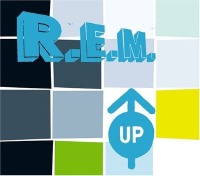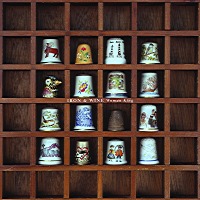
When R.E.M. released Up in 1998, long time fans were polarized. Some, expecting the trademark R.E.M. sound, were surprised and disappointed by the drum machines and electronic textures. Others, aware of the band’s necessary change in direction following the departure of founding member and drummer Bill Berry, listened with an open ear. I fell somewhere in the middle: I thought there were some outstanding tracks but overall felt that the performances were tentative and uneven. Now Rhino has reissued the album in a new 5.1 DVD mix (along with all of R.E.M.’s other Warner Brothers output), and with a new mix and seven years in between, I’ve got a new perspective on the album. Up shows a band in transition, but much more solidly grounded in their old sound than it seemed at the time—and writing some of their finest songs of their entire career.
Up’s sequence is probably the least satisfying part of the album. Opening with “Airportman,” a buzzing, ambient track with no discernable lyrics, the track is both unapproachable and unmemorable—not a good omen. But from there the album scales some serious heights, particularly on “Hope” and “Walk Unafraid.” The former remains a spine-chilling portrait of mingled hope and fear in the face of some unspecified grave illness. The latter may be one of the top ten songs R.E.M. has ever written, as shown by their electrifying performances of it on tour in 2003. So what’s the problem? With “Walk Unafraid” as track 9 of 14, there are five lesser tracks between it and the end of the album. Anticlimactic, for sure.
I approached the reissue hoping that it would clean up some of the fuzzy production and allow for the sort of revelations that hearing the material live provided. I got some of those moments—but few. The band really was feeling their way through new musical styles, and no amount of sonic wizardry can keep layers of drum machines and keyboards from dragging down some of the songs (“Diminished”). However, “Airportman” gains an increased sense of presence and menace and “Walk Unafraid” sounds more vital. And “At My Most Beautiful” reclaims some of its promise as a Brian Wilsonesque sonic tapestry (though the deaf-in-one-ear Wilson would have preferred mono to the 5.1 mix)—in particular, a gorgeous cello line that’s buried in the stereo mix pops to the front on the 5.1 version. It’s interesting that Elliott Scheiner, the producer on the remaster, opted not to clean up the original recording—the fractional second of studio chatter is still there just before the mandolin enters on “Daysleeper,” for instance, but if anything this humanizes the occasionally too-spacious sound of the 5.1 mix.
Hearing the newly reengineered songs opened my ears to them all over again. I think the slightly flat mix of the original release was partly responsible for my muted reaction. Up has now regained its place for me among R.E.M.’s top albums. More emotionally naked than just about any other release, and more sonically adventurous than any of their other later albums, this is a band confronting massive change head on and doing it with refreshing honesty and maturity.
A word about the reissue: fans looking for bonus songs will be disappointed, but that’s not to say there’s nothing new. The package contains a CD that is essentially identical to the original CD version, a booklet with excellent liner notes, and a DVD containing the 5.1 mix of the songs, a bonus video shot during the studio sessions with live-in-studio versions of “Daysleeper,” “Lotus,” and “At My Most Beautiful,” lyrics, and photos. There’s nothing revelatory in the video, unless it’s that the group was clearly thinking hard about live performances of this material even while the record was being made.
This reissue is one in a series of R.E.M.’s Warner Brothers albums to be re-released in CD+DVD format. Also available are Green, Out of Time, Automatic for the People, Monster, New Adventures in Hi-Fi, Reveal, In Time: the Best of R.E.M. 1989–2003, and Around the Sun. (Linked titles point to BlogCritics reviews of the reissued albums.)
(Originally published at BlogCritics.)


